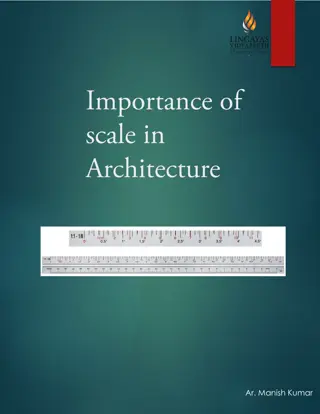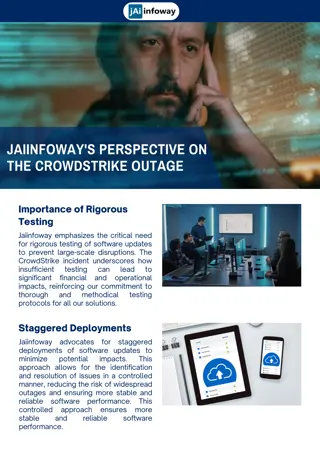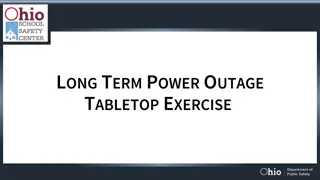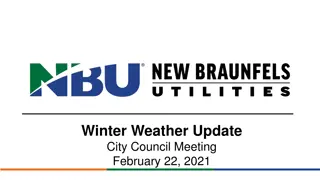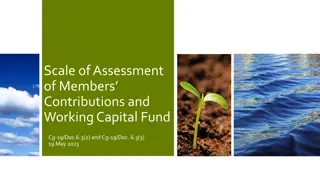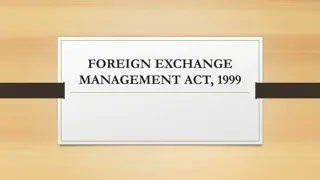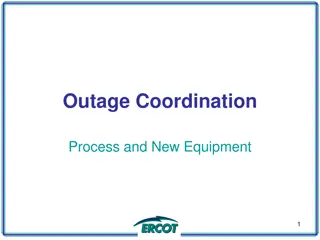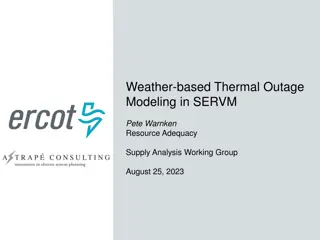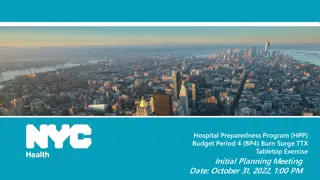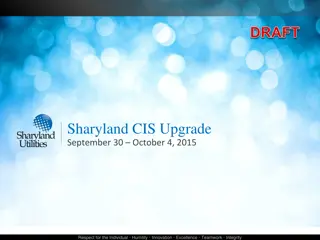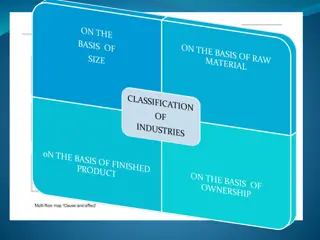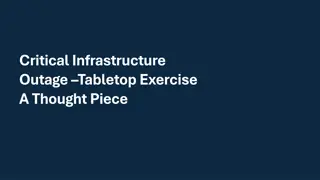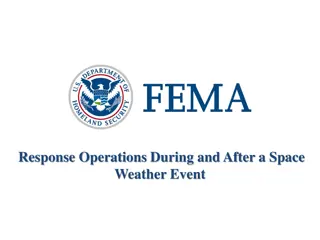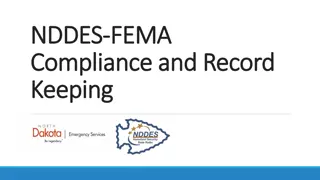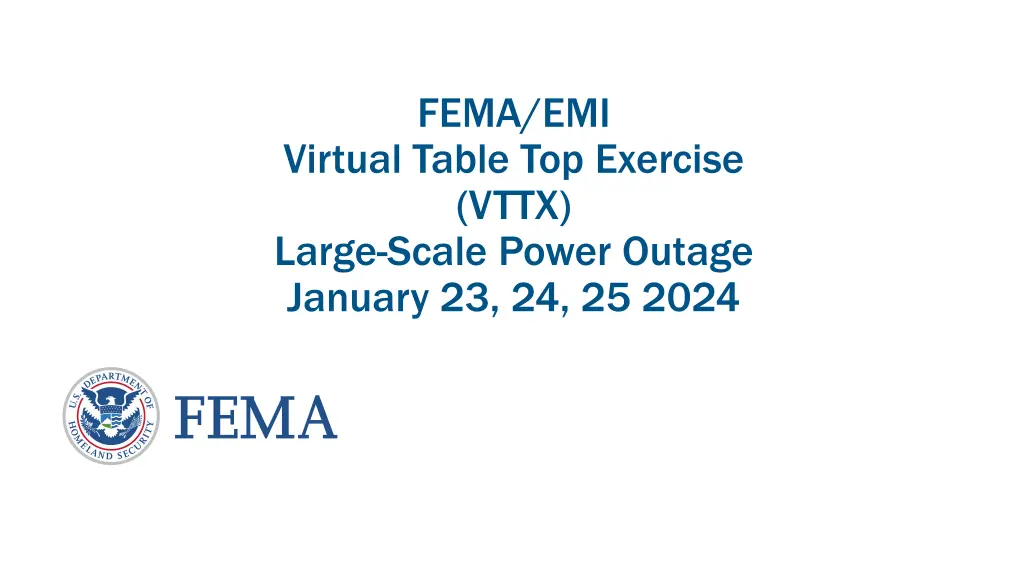
Interactive VTTX Exercise: Responding to Large-Scale Power Outage
Participate in a virtual table-top exercise on Jan 23-25, 2024, focusing on the role of organizations in responding to a power outage. Enhance coordination at different levels and improve emergency response abilities.
Download Presentation

Please find below an Image/Link to download the presentation.
The content on the website is provided AS IS for your information and personal use only. It may not be sold, licensed, or shared on other websites without obtaining consent from the author. If you encounter any issues during the download, it is possible that the publisher has removed the file from their server.
You are allowed to download the files provided on this website for personal or commercial use, subject to the condition that they are used lawfully. All files are the property of their respective owners.
The content on the website is provided AS IS for your information and personal use only. It may not be sold, licensed, or shared on other websites without obtaining consent from the author.
E N D
Presentation Transcript
FEMA/EMI Virtual Table Top Exercise (VTTX) Large-Scale Power Outage January 23, 24, 25 2024
Welcome and Introductions Opening Remarks: Emergency Management Institute (EMI) Introductions: EMI Attending Agencies and Federal Emergency Management Agency Federal Emergency Management Agency 2
Exercise Scope Focus on the role of your organization(s) in response to potential consequences of a large-scale power outage in your area, as well as the interdisciplinary and interagency coordination at the Federal, Native American, regional, State, and local levels. Federal Emergency Management Agency Federal Emergency Management Agency 3
Exercise Objectives 1. Review participants knowledge, skills, and abilities to effectively conduct emergency response and recovery. 2. Enable participants to better coordinate response operations with counterparts from local government, state governments, tribal, territorial, federal agencies, private sector organizations, and nongovernmental agencies. 3. Allow participating locations to share real-time related preparation, response and recovery solutions with all participants. Federal Emergency Management Agency Federal Emergency Management Agency 4
Exercise Overview This is a four-hour, continuous, interactive exercise that will require schedule discipline. The VTTX consists of: Introductions Three Modules (Preparedness, Response, Recovery) Participant engagement encouraged both locally and cross-community. Time awareness during questions, brief outs, etc. Federal Emergency Management Agency Federal Emergency Management Agency 5
Exercise Schedule Activity Activity Introductions Module 1: Preparedness Module 2: Response Module 3: Recovery Close Out Time Time 15 Minutes 60 Minutes 60 Minutes 60 Minutes 15 Minutes Federal Emergency Management Agency Federal Emergency Management Agency 6
Assumption and Artificialities The scenario is plausible, and events occur as they are presented. There is no hidden agenda, and there are no trick questions. All players receive information at the same time. Federal Emergency Management Agency Federal Emergency Management Agency 7
Ground Rules 1. Do NOT critique the scenario Trying to find holes or inconsistencies in the scenario is counter-productive and disruptive; the scenario should stimulate discussion. 2. Draw from your previous experience As you participate, please utilize your knowledge of how the Whole Community works together in response/recovery situations. 3. Do NOT assume information If questions arise that are not answered by the provided material, please ask the facilitator to address the issue with the virtual group. Participation is encouraged Speak freely, respect others when they are speaking Participate in your disaster role as if the event were occurring Processes and decision making are more important than the details The facilitator's job is to help you you come up with solutions 4. 5. Federal Emergency Management Agency Federal Emergency Management Agency 8
Module 1: Situation Timeline Monday, January 22 @ 6:30 A.M. Local National Weather Service forecasts indicate a strong chance of a moderate to severe Thunderstorms throughout your town and surrounding areas in the next 72 hours. There is currently a line of severe weather events heading into your area with the protentional for damaging winds and hail. Federal Emergency Management Agency 10
Module 1: Situation Timeline Monday, January 22 @ 5:30 P.M. The media is reporting that there are long lines at the supermarket, and they are starting to sell out of some items. There have also been reports of long lines at gas stations. Tuesday, January 23, @ 07:30 A.M. The NWS updates the forecast now calling for severe thunderstorms with high winds. The possible impacts are Dangerous Driving Conditions Downed Trees and Power Lines Widespread Power Outages Federal Emergency Management Agency 11
Key Issues Approaching storm Possible power outages Dangerous driving conditions Reports of a surge of customers at gas stations and supermarkets. Public notification Federal Emergency Management Agency 12
Module 1: Discussion Questions 1. Should an EOC be staffed? 2. Are you starting to think of a staffing plan? 3. What are some reasonable assumptions and what assumptions should be avoided in regard to this storm? 4. What warning and notification systems are available for the community? 5. What are some of the ways you collect information? 1. What are some of the ways you validate that information? 6. What agencies need to be involved at this point? 7. What are the incident and resource priorities? 8. What are some of the possible needs from the utility companies? And what do they need from Emergency Management? Federal Emergency Management Agency Federal Emergency Management Agency 13
Module 1: Brief Out EMI will facilitate the brief out discussion from each site. Please keep each brief out concise, and to the point. Please feel free to ask questions. Federal Emergency Management Agency Federal Emergency Management Agency 14
Module 2: Situation Timeline Thursday, January 25 2:00 AM Storms hits your area The rain starts to fall; as the storm moves in. Wind gust are starting to hit 65 MPH. Debris begins to cover yards and roadways. Thursday, January 25, 7:00 AM The storm intensify, causing small power outages to communities. A local hospital is already on back up power leading to some concern within the leadership at the hospital. Hospital can stay on back up power for 12 more hours. Public Utilities have been notified and are working the issue but as the storm gets strong more power outages are popping up. Federal Emergency Management Agency Federal Emergency Management Agency 16
Module 2: Situation Timeline Thursday, January 25, 10:00 AM 3,000 homes without power News reports are stating over 20,000 people without power There are rumors that 5 people have died from the storm Thursday, January 25, 3:00 PM It is now being reported from the media that there are 7,000 customers in your area without power. Numerous traffic accidents are being reported causing congestion on the roadways. The utilities are reporting that power could be out for 18 hours plus for some areas. Federal Emergency Management Agency Federal Emergency Management Agency 17
Key Issues The storm has hit your area. Wind speeds are increasing. The size of the power outage is increasing and might last longer than 18 hours Currently there are about 7,000 customers without power Unknown status of shelters Customers are becoming angry about the power outage. Several deaths due to lack of power (Rumored) Traffic in surrounding area is getting congested and traffic collisions are increasing Possible misinformation from the media. Federal Emergency Management Agency 18
Module 2: Discussion Questions 1. How is situational awareness at this point? How to you improve SA? How will a common operating picture be maintained within the incident command structure? What types of communications and coordination with law enforcement, EMS, fire, hospitals and other agencies would occur? What information should be released to the public? How are students, parents and teachers being evacuated from school property tracked? How are students and parents being reunited? How is that publicized (without power)? 6. What additional resources are needed to restore power? 7. Who is designated as the Public Information Officer (PIO) to handle both local and national news inquiries? 8. How are communications and emergency instructions to the public being handled? What steps are being taken to deal with rumors? 2. 3. 4. 5. Federal Emergency Management Agency Federal Emergency Management Agency 19
Module 2: Brief Out EMI will facilitate the brief out discussion from each site. Please keep each brief out concise, and to the point. Please feel free to ask questions. Federal Emergency Management Agency Federal Emergency Management Agency 20
Module 3: Situation Timeline Monday, January 29, 12:00 PM 1,000 homes that include 5,000 people are still without power A state and federal disaster declaration was approved Most business reopened and people returning to work. Calls for Police, Fire and EMS have curtailed to normal service Monday, January 29, 3:00 PM Recovery efforts are still ongoing and an estimated 700 are still living in shelters and hotels (the ones with power). Power should be returned to all customers by the end of the week. Media is still reporting on the frustration of the community over the response to the storm. Federal Emergency Management Agency Federal Emergency Management Agency 22
Module 3: Key Issues Power still out for an estimated 5,000 people. Logistics of replacement equipment/supplies. Utility crews still working to restore power to some areas. Media is still broadcasting live on government failures during the response. Some folks are still in hotels and shelters. Federal Emergency Management Agency Federal Emergency Management Agency 23
Module 3: Discussion Questions 1. What are the operational goals of recovery? Which of these goals are within the control of community officials? 2. What potential coordination and policy issues could arise from decisions regarding the prioritization of repair and cleanup sites and resources? 3. What is the role of policy and decision makers in the gradual transition from response to recovery operations? 4. How will utility companies and other entities work with the incident command? Will they be formally included in the planning and operations process? 5. How long can folks stay in the shelters before you transition to a long-term solution? 6. What affects will the transition from response to recovery have on emergency services? 7. What decisions should be made by policy and decision makers concerning resource management during the recovery phase? 8. How will information and resource management coordination occur between local, state, and Federal agencies during the recovery period? Federal Emergency Management Agency Federal Emergency Management Agency 24
Module 3: Brief Out EMI will facilitate the brief out discussion from each site. Please keep each brief out concise, and to the point. Please feel free to ask questions. Federal Emergency Management Agency Federal Emergency Management Agency 25
ENDEX Lessons Learned Actions for Follow-Up Comments/Feedback Credit/Certificate Federal Emergency Management Agency 26
Contact Contact Reginald Godfrey Training Specialist Integrated Emergency Management Branch Reginald.Godfrey@fema.dhs.gov


